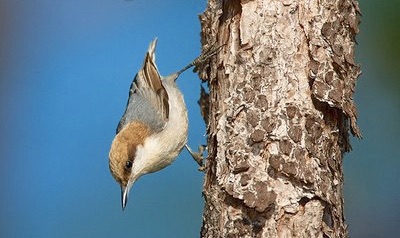
Bahama Nuthatch observations fuel hope for the species
One of the rarest birds in the Western Hemisphere, the Bahama Nuthatch, has been rediscovered by research teams searching the island of Grand Bahama.
The finding is particularly significant because the species had been feared extinct following the catastrophic damage caused by Hurricane Matthew in 2016, and had not been found in subsequent searches.
It is unclear how many nuthatches may be left. Observations of two birds together and other single birds (including a juvenile) scattered across miles of forest indicate that five or more birds could survive.
The Bahama Nuthatch is an Endangered species, only known from native pine forest on Grand Bahama Island, which lies approximately 100 miles off Palm Beach, Florida. Closely related to the Brown-headed Nuthatch of the southeastern United States, the Bahama Nuthatch is considered by some authorities to be a distinct species (Sitta insularis) while others regard it as a subspecies (Sitta pusilla insularis) of the Brown-headed Nuthatch (Sitta pusilla).
The Bahama Nuthatch can be distinguished from North American populations by its longer beak, shorter wings, whiter belly, and distinctive vocalizations that differ from the mainland population.
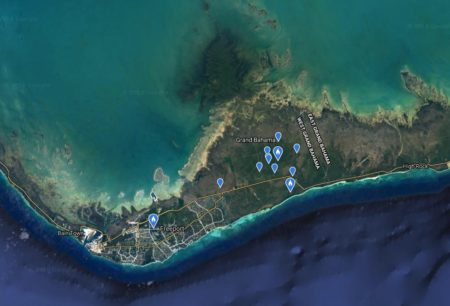
Common on Grand Bahama in the 1960s, the species declined drastically. Extensive population surveys in the mid-2000s by Hayes et al (2004) and Lloyd and Slater (2009) confirmed that the birds had become very rare; it was estimated that 1,000 to 2,000 individuals remained, all within the “Lucaya Estates” area. It had not been seen since Hurricane Matthew hit Grand Bahama in October 2016.
Two search teams worked in coordination with Bahamas National Trust (BNT) to rediscover the bird during the breeding season, starting in April of this year. One team was led by Zeko McKenzie and his students at the University of The Bahamas-North, supported by American Bird Conservancy, and another by University of East Anglia (UEA) masters students Matthew Gardner and David Pereira, in conjunction with BirdLife International.
Both teams first observed nuthatches in May 2018, documenting their observations with photographs. McKenzie’s team observed five birds in all, starting with a sighting of two individual Bahama Nuthatches together on May 1. The next sighting was on May 23, over a mile from the first observation, and included a juvenile bird accompanying a Bahama Warbler. The juvenile was distinguished from adults by the lack of distinctive brown plumage on the crown of the bird’s head. A video recording of this juvenile Bahama Nuthatch by McKenzie was the earliest documentation of the species’ continued survival in 2018, and was followed by additional photographs of adult birds by both research teams later in May and in subsequent months.
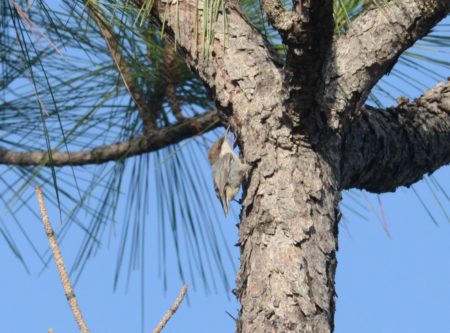
Dr. Diana Bell, from UEA’s School of Biological Sciences, said, “The Bahama Nuthatch is a critically endangered species, threatened by habitat destruction and degradation, invasive species, tourist developments, fires and hurricane damage.”
Regarding the moment when he saw the Bahama Nuthatch, Matthew Gardner recalled, “We had been scouring the forest for about six weeks, and had almost lost hope. At that point we’d walked about 400km (250 miles). Then, I suddenly heard its distinctive call and saw the unmistakable shape of a nuthatch descending towards me. I shouted with joy, I was ecstatic!”
“The photographs clearly show this distinctive species and cannot be anything else,” said Michael Parr, President of American Bird Conservancy. “Fortunately this is not a hard bird to identify, but it was certainly a hard bird to find.”
Parr continued, “Despite the critical situation for this species, other birds—such as the New Zealand Black Robin—have recovered from tiny populations. We are optimistic that conservation can also save the Bahama Nuthatch.”
All of the Bahama Nuthatches was observed within the Lucaya Estates, an area previously logged during the mid-1900s and since developed with many miles of roads for residential development.
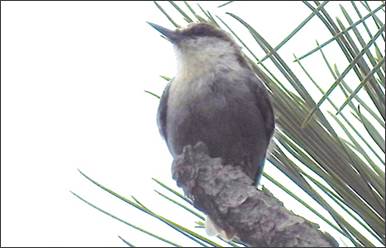
A last sighting and photographs of a pair of Bahama Nuthatches was made by Erika Gates, well-known Grand Bahama birder and guide and BirdsCaribbean Director, on June 28, 2016, prior to Hurricane Matthew on October 6, 2016. She is elated at the recent sightings of the bird. “This will hopefully generate sufficient excitement in the scientific community to begin aggressive research and map a much needed conservation strategy,” she commented.
Bahamian researcher Zeko McKenzie said, “Although the Bahama Nuthatch has declined precipitously, we are encouraged by the engagement of conservation scientists who are now looking for ways to save the species.” Zero had previously set up nest boxes for the Bahama Nuthatch, but they were not used.
“The Bahamas National Trust feels that research on endangered species, such as the Bahama Nuthatch, is really important,” said Shelley Cant-Woodside, Director of Science and Policy of the Bahamas National Trust, “especially in the face of a changing climate.”
“These recent observations confirm that the Bahama Nuthatch is not extinct; it is critical that we raise awareness about the precarious status of this unique species and do all we can to make sure it survives,” declared Lisa Sorenson, Executive Director, BirdsCaribbean.
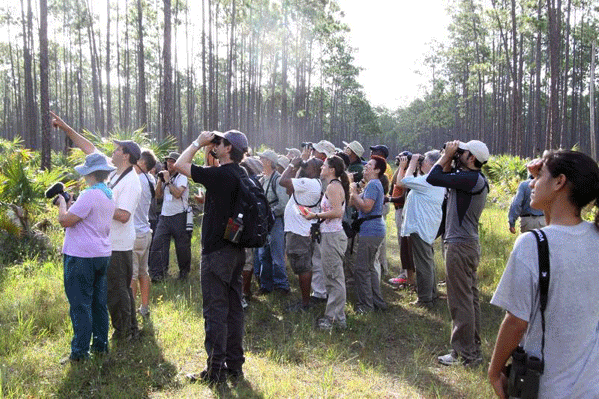

shouldnt you be looking for these on andros instead of or in addition to grand bahamas?
Hi Ted, Thanks for your question. Certainly there is suitable pine forest habitat available on Andros, Great Abaco and also New Providence, but as far as I know, the bird has never been seen anywhere but on Grand Bahama. (the other islands have been partially searched and surveyed by birders and scientists studying other species). We don’t know if the bird previously occurred on these other islands in the historical past. But yes, we should keep looking for it i other pine forests (it could have been overlooked) and also consider these islands as places for future introductions, if the population on Grand Bahama can be recovered over time to good numbers. This would be an insurance policy against extinction of the species from a future hurricane, disease, habitat destruction or other threats on Grand Bahama.
It has never been sighted on Abaco, despite vast areas of arguable suitable pine habitat (records have been kept since around 1950).
Thanks for your information and insights Keith! We can always hope that perhaps a small population lives deep within the pine forests of Abaco, or could perhaps be reintroduced there some day. Would you say that the area has been suitably surveyed? All the best, Lisa Sorenson (Executive Director, BirdsCaribbean)
Lisa, I don’t think any targeted nuthatch survey has been carried out on Abaco. There are sharp and experienced eyes though! That said, the bird is tiny and the pine wood areas are huge. I guess it is possible that a handful exist in remote parts – eg in the National Park – that are rarely if ever visited because access is very limited. The nesting parrot researchers / guardians / BNT there have never reported one. Maybe there should be a survey while this topic is in the spotlight…
Good suggestion, there is certainly suitable habitat available, yes, we should be looking there as well! Volunteer surveyors welcome!
I look forward to progress updates. When the Chatham Islands Black Robin was down to 5 birds, their recovery was the result of perseverance and innovation and good timing., not forgetting the amazing rejuvenation of an old female robin named Old Blue. That was in the 1970 to 1990 era. Much was learned from that time and since then science and field experience has added to the tools and knowledge needed to ensure this species continues.
Thanks, Robyn, for your insights and encouraging words. We are optimistic that this species will survive!